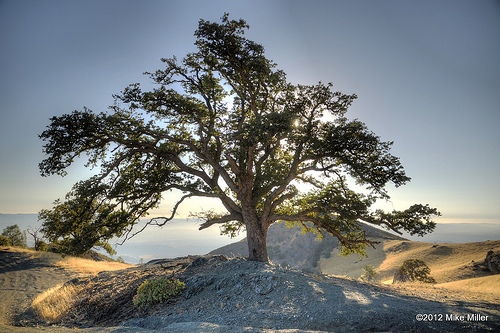Oaks are some of the defining features of the California landscape. Twenty different species of oaks are found in California, eleven of which occur in the Los Padres National Forest. They range from shrubby oaks that grow just a few feet tall, to ancient oak trees that can reach heights of up to 120 feet and diameters of up to twelve feet! Some oaks in the Los Padres National Forest have survived for five or six centuries, making them one of the oldest living organisms in our region. Many California oaks are endemic and are not found outside of the state.
Benefits of Oaks
Oak woodlands provide important wildlife habitat, scenic landscapes, shade for weary backcountry travelers, and stand as ancient sentries of bygone eras. They play a particularly important role in maintaining our state’s biodiversity. Nearly one hundred bird species are found in oak woodlands. Rare wildlife like California spotted owls, foothill yellow-legged frogs, and western spadefoot toads depend on blue oak woodlands for survival. Small mammals like salamanders, snakes, and lizards rely on downed branches and logs for shelter. Oaks also provide shade over rivers and streams, maintaining ideal water temperatures for fish and other aquatic life.
In addition, oaks have been used for centuries for medicinal, practical, and ceremonial purposes. Native Americans throughout California used acorns to cure everything from dizziness to fever. Black and brown dyes were created from oak tannins and used for decoration, tattoos, and to camouflage fishing nets. Perhaps most importantly, oak trees, branches, and acorns were used in a number of important ceremonies.
Here are some oak species that you may stumble upon while exploring the Los Padres National Forest. The next time you visit the forest, see how many you can identify!
Oak Trees in the Los Padres
The Los Padres National Forest contains six of the state’s nine oak tree species. Three of them — blue oak, valley oak, and California black oak — are classified as Management Indicator Species (“MIS”) because they are good indicators of the effects of land use activities on the overall health of the ecosystem. When monitoring indicates that oak populations are declining, forest officials are required to make adjustments in how they manage the area.
Blue Oak (Quercus douglassi)

© Lynn Watson
Blue oaks are the most drought-tolerant of all oaks. They germinate quickly once conditions become favorable, rather than waiting for the spring, and their roots grow rapidly. Mature blue oaks have a relatively smaller canopy when compared with other oak species, and a waxy coating on its leaves helps to conserve moisture. When severe droughts do occur, blue oaks alter their leaves — or even drop their leaves completely and go dormant — to make them better able to withstand stresses. These characteristics combine to make the blue oak one of the most resilient and widespread trees in California. Despite this resiliency, blue oaks are poorly represented on public lands.
Because of their rarity and vulnerability to a variety of threats, the Blue Oak Woodlands Area of High Ecological Significance was established in the Los Padres National Forest, west of Garcia Mountain in San Luis Obispo County, to better protect the blue oak woodlands of this area. The Los Padres National Forest contains some of the southernmost stands of blue oaks, and blue oaks here grow at elevations much higher than in areas further north.
Valley Oak (Quercus lobata)
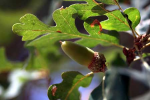
© Univeristy of California
Reaching ages of 600 years and heights of 100 feet, valley oaks are the grandest of all North American oaks. They are most prevalent at lower elevations, typically occupying the valley floor and lower foothills up to 5,600 feet in elevation. Valley oaks can have trunks up to eight feet in diameter that support numerous giant limbs extending upwards and outwards from the main stem.
Valley oaks develop a widely spreading canopy of giant limbs covered in distinctive “alligator skin” bark. Valley oaks have been eliminated from much of their former range by clearing for agricultural and urban development and the lowering of groundwater tables — some estimates place the reduction at 90%. In the stands that remain, scientists are concerned because valley oaks are not regenerating enough young oaks to replace those that are dying.
California Black Oak (Quercus kelloggii)

© University of California
Unlike most other oaks, the California black oak grows with a mix of other trees including conifers, pines, and firs. Amongst these evergreen trees, black oaks are often the only splash of non-green color throughout the year.
In the winter, when black oaks have shed their leaves, mistletoe moves in to take advantage of the increased amount of available light. Though mistletoe is parasitic, it is a photosynthesizer and rarely kills its host. Native Americans believed that the life-spirit of the black oak resided in the mistletoe during the winter. This is possibly where the tradition of bringing mistletoe into the home during the cold months arose from. Black oaks may grow up to 80 feet tall and, as their name suggests, have very dark bark. The leaves are deep green and very angular. The acorns of the black oak were the favorite of Native Americans who prized them for their superior flavor and ease of storage. The Los Padres National Forest contains only a few scattered populations of black oaks.
Coast Live Oak (Quercus agrifolia)
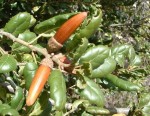
© Las Pilitas Nursery
Coast live oaks are masterfully built when it comes to maximizing photosynthetic efficiency. Small leaves in the upper canopy capture the majority of light that hits them, while broader, flatter leaves in the inner canopy capture what light is missed by the upper canopy. These two layers of sun and shade leaves allow the coast live oak to make the most out of the sunlight that it receives. They can have trunks up to 12 feet in diameter with large branches spreading out dozens of feet from the center. Walking in a forest of coast live oaks is both beautiful and eerie, as the unique forms of these trees cast a strange light on their surroundings.
Coast live oaks can live up to 250 years, and are characterized by large, spreading branches that often run parallel to the ground. Their oval-shaped leaves are dark green in color and remain on the tree year-round.
Interior Live Oak (Quercus wislizenii)
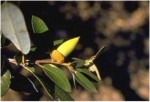
© UC Cooperative Extension
The inland counterpart to the coast live oak, the interior live oak grows further away from the coast and is widespread below 5,000 feet elevation. Unlike the coast live oak, the interior live oak has no hairs on the underside of its leaves. Interior live oaks also tend to be slightly smaller and shorter than coast live oaks, and have shorter live spans. Interior live oaks also grow as a shrubby variety in chaparral. Trees tend to have a full, rounded canopy of leaves that is as broad or broader than tall, with numerous horizontal branches that parallel or intersect the ground.
Canyon Oak (Quercus chrysolepis)
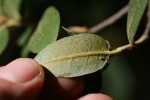
© UC Cooperative Extension
The canyon oak is the most widespread of the California oak species, ranging from Oregon to Baja California. They’re able to survive at elevations from sea level to 9,000 feet and do so by greatly altering their form based on their surrounding environment. In dense forests, it takes on a narrow cylindrical shape to reach the sunlight. In rocky areas, gnarled canyon oaks twist around boulders and cliff faces. And in drier areas, canyon oaks appear as low-spreading shrubs. Whatever the form, canyon oaks have distinctive leaves that set them apart from other oaks. Their upper leaf surfaces are bright green and shiny, while lower surfaces are pale blue or grayish with hairs that feel like felt. Its wood is the hardest of any western oak. Canyon oaks are found throughout the Los Padres National Forest.
Shrub Oaks in the Los Padres

© Jerry Kirkhart
More than half of California’s oak species are shrubs commonly found in chaparral. In fact, the term chaparral is derived from chaparro, a Spanish word for evergreen oak that was bestowed on shrub oaks by early California explorers. These shrub oaks have tough, spiny leaves and an interwoven canopy of small branches that grow six to fifteen feet tall. Five species of shrub oaks occur in the Los Padres National Forest:
- Scrub Oak (Quercus berberidifolia) – One of the two most common shrub oaks in California. It occurs throughout the Los Padres National Forest.
- Leather Oak (Quercus durata) – Leather oak is confined to nutrient-poor serpentine soils, so it grows small with tough leaves and extensive roots. Its leaves almost look curled and its acorns are rotund and stubby. The Los Padres contains some of the southernmost stands of leather oak.
- Tucker Oak (Quercus john-tuckeri) – Found only on mountain slopes along the desert edge, its hairy, grayish bark gives the whole shrub a dull cast. Acorns are attached directly to the branches without a stalk.
- Palmer Oak (Quercus palmeri) – Palmer oaks typically grow in semi-desert chaparral.
- Nuttall’s (“Coastal”) Scrub Oak (Quercus dumosa) – Coastal scrub oak is restricted to bluffs, headlands, and hillsides within sight of the ocean from Santa Barbara south to Baja California. It is among the rarest of the shrub oaks, and the U.S. Forest Service has classified it as a “Sensitive Species” due to the amount of habitat that’s been destroyed by coastal development. While Nuttall’s scrub oak has not been formally documented in the Los Padres National Forest, it is found in close proximity to the forest boundary and may occur there.
False Oaks: Tanoak & Poison Oak
Oaks belong to the genus Quercus and are set apart from their close relatives — beeches and chestnuts — by their distinctive acorns. Two plants that are commonly called oaks — tanoak and poison oak — are not really oaks at all.
Tanoak
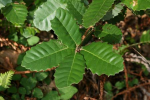
© UC Cooperative Extension
Tanoak (also called tanbark oak) is not a true oak, but is a close relative in the beech family. The name comes from its tannin-rich bark, which was used for tanning leather before modern synthetic tannins replaced it. It has large leathery leaves with clearly visible veins that run parallel to each other, and its acorns have bristled or spiked caps. It is one of the only acorn-bearing trees found in redwood forests. Tanoaks are especially susceptible to sudden oak death. In the Los Padres National Forest, tanoaks are found primarily in the Monterey Ranger District. Small, isolated tanoak populations are also found in the Transverse Ranges in Santa Barbara and Ventura counties, marking the species’ southernmost extent.
Poison Oak
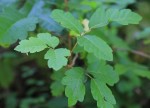
© Shiny Things
Poison oak is closely related to the cashew family. Its shiny, lobed leaves do resemble leaves of true oaks, but the leaves of poison oak are always divided into three separate leaflets (“Leaves of three, let them be!”). True oaks have singular leaves. Also unlike true oaks, poison oak flowers are insect-pollinated and produce berries instead of acorns.
Oak Place Names
Given the prevalence and diversity of oaks in the Los Padres National Forest, it’s no wonder that the mighty oak is reflected in many of its place names: Nineteen Oaks Camp (along the Santa Cruz Trail), Oak Camp (along the Chorro Grande Trail), Tan Oak Camp (in the Ventana Wilderness), Oak Canyon (a tributary to the Sisquoc River), White Oaks Campground (along Tassajara Road), Live Oak Spring (along Alamo Creek), Oak Spring (at Santa Barbara Potrero), Oak Flat (yes, all three of them – one along Sespe Creek, a second along Squaw Flat Road, and a third along Piru Creek), Oak Flat Spring (along Piru Creek), and the Live Oak Day Use Area (along Paradise Road), among many others.
Threats to Oak Survival
Oaks within the Los Padres National Forest face several major threats: a disease called sudden oak death, lack of oak tree regeneration, and overgrazing within oak woodlands.
Sudden Oak Death
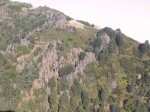
The effects of sudden oak death in Big Sur.
In 1995, several species of oak tree started dying off suddenly, often transitioning from an apparently healthy tree to a dead tree in a matter of weeks. After years of research, a fungus-like pathogen was determined to be responsible for this “sudden oak death” which remains the name of the disease to this day. This pathogen, Phytophthora ramorum, was transported to the United States from abroad. Certain oak species are particularly susceptible to this disease, including California black oak, coast live oak, and canyon live oak. Other oaks, such as valley oak, and blue oak, seem to be resistant to it. This disease is particularly prevalent in the Monterey portion of the Los Padres National Forest, where large numbers of dead oaks fueled massive wildfires in 2008. The race is on to find a cure before this pathogen seriously damages oak populations across the nation.
If you visit the Monterey County portion of the Los Padres National Forest, click here to read about simple steps you can take to prevent spreading this pathogen.
Lack of Oak Regeneration
Some species of oaks in California are not regenerating adequately – as older oaks die, there are fewer and fewer younger oaks sprouting to take their place. Possible causes include grazing of seedlings by wildlife and livestock, competition from nonnative annual grasses, and an unnatural abundance of acorn‐eating animals. Three California oak species (blue oak, valley oak and Engelmann oak) seem to be particularly hard-hit by lack of regeneration, and if the trend is not reversed, oak woodlands and savannahs could eventually convert to shrub fields or bare pastures. A principal factor believed to significantly contribute to poor oak regeneration in California is livestock grazing.
Livestock Grazing
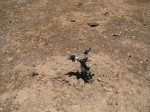
A young oak destroyed by livestock in the Los Padres National Forest.
In heavily grazed areas, livestock grazing suppresses oak regeneration more than any other factor. Cattle eat acorns, reduce or eliminate the litter layer beneath trees, and compact the soil, reducing the potential for seedling establishment. Surviving seedlings are often consumed or trampled, which shortens the life of individuals and depletes the seedling bank. Even in moderately grazed areas, consumption of leaves and branches by livestock seriously hinders oak sapling growth. Cattle also stress older trees as they often crowd beneath them for shade during the day. Blue oaks are particularly harmful to these impacts, as 87% of the state’s blue oak woodlands on national forest lands are within grazing allotments.
Oak Conservation
Los Padres ForestWatch is committed to preserving the oak trees and oak woodlands that characterize and define our region. We will continue to urge the Forest Service to ensure that livestock grazing does not further inhibit oak regeneration. We will also continue to demand the protection of oak trees from vegetation clearing projects in the forest. And ForestWatch will continue working with forest officials to ensure that the overall health of MIS oak populations are monitored regularly to prevent further declines in our region.
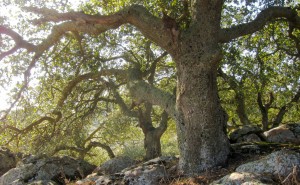
© Miguel Vieira
The Oak Woodlands Conservation Act of 2001 established the California Oak Woodlands Conservation Program, which provides funds to local governments and nonprofit organizations to protect oaks statewide. In 2004, California’s landmark environmental protection statute was also amended to ensure that any future development projects avoid or minimize impacts to oak woodlands. Several counties and cities have also enacted oak tree protection ordinances and have approved Oak Woodlands Management Plans.
The U.S. Forest Service has established the Blue Oak Woodland Area of High Ecological Significance. In 1997, an interdisciplinary team from the U.S. Forest Service recommended that the agency adopt a regional-scale conservation strategy for southern California’s oak woodlands and forests. It is unknown whether this strategy was ever finalized or implemented.
The Oak Woodlands Conservation Workgroup — a project of the University of California — has worked for more than 25 years to conduct research and outreach focused on conserving California’s native oak species. Many other of our partner organizations are also working to conserve oak habitats at the statewide level.

